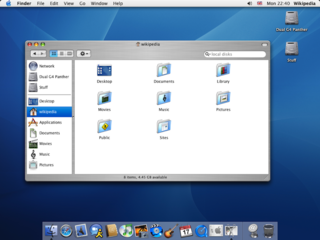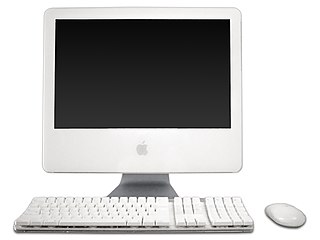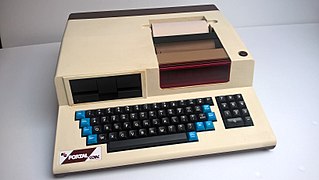
PowerPC is a reduced instruction set computer (RISC) instruction set architecture (ISA) created by the 1991 Apple–IBM–Motorola alliance, known as AIM. PowerPC, as an evolving instruction set, has been named Power ISA since 2006, while the old name lives on as a trademark for some implementations of Power Architecture–based processors.

The Power Macintosh, later Power Mac, is a family of personal computers designed, manufactured, and sold by Apple Computer, Inc as the core of the Macintosh brand from March 1994 until August 2006.

The Matra & Hachette Ordinateur Alice is a home computer sold in France beginning in 1983. It was a clone of the TRS-80 MC-10, produced through a collaboration between Matra and Hachette in France and Tandy Corporation in the United States.

The Power Mac G5 is a series of personal computers designed, manufactured, and sold by Apple Computer, Inc. from 2003 to 2006 as part of the Power Mac series. When introduced, it was the most powerful computer in Apple's Macintosh lineup, and was marketed by the company as the world's first 64-bit desktop computer. It was also the first desktop computer from Apple to use an anodized aluminum alloy enclosure, and one of only three computers in Apple's lineup to utilize the PowerPC 970 CPU, the others being the iMac G5 and the Xserve G5.
MorphOS is an AmigaOS-like computer operating system (OS). It is a mixed proprietary and open source OS produced for the Pegasos PowerPC (PPC) processor based computer, PowerUP accelerator equipped Amiga computers, and a series of Freescale development boards that use the Genesi firmware, including the Efika and mobileGT. Since MorphOS 2.4, Apple's Mac mini G4 is supported as well, and with the release of MorphOS 2.5 and MorphOS 2.6 the eMac and Power Mac G4 models are respectively supported. The release of MorphOS 3.2 added limited support for Power Mac G5. The core, based on the Quark microkernel, is proprietary, although several libraries and other parts are open source, such as the Ambient desktop.

Mac OS X Panther is the fourth major release of macOS, Apple's desktop and server operating system. It followed Mac OS X Jaguar and preceded Mac OS X Tiger. It was released on October 24, 2003, with the retail price of US$129 for a single user and US$199 for a five user, family license.
PowerPC G4 is a designation formerly used by Apple to describe a fourth generation of 32-bit PowerPC microprocessors. Apple has applied this name to various processor models from Freescale, a former part of Motorola. Motorola and Freescale's proper name of this family of processors is PowerPC 74xx.

The iMac G5 is an all-in-one personal computer that was designed, manufactured and sold by Apple Computer from August 2004 to March 2006. It is the final iMac to use a PowerPC processor, making it the last model that could natively run Mac OS 9 (Classic) applications.

Micral is a series of microcomputers produced by the French company Réalisation d'Études Électroniques, beginning with the Micral N in early 1973. The Micral N was one of the first commercially available microprocessor-based computer.

Toshiba Pasopia 7 is a computer from manufacturer Toshiba, released in 1983 and only available in Japan, with a price of $1350.

The VG5000μ is a computer created by Philips in 1984. It was manufactured in Le Mans by Radiotechnique (RTS) and marketed under the Philips, Radiola and Schneider brands.

In the 1980s the French Thomson company produced a range of 8-bit computers based on the 6809E CPU.

Portal R2E CCMC was a portable microcomputer designed and marketed by the Réalisation et Etudes Electroniques department of the French firm R2E Micral, and officially appeared in September 1980 at the Sicob show in Paris. Osborne 1, the first commercially successful portable computer, was only released eight months later, on 3 April 1981.
The Thomson TO16 or Thomson TO16PC is a PC compatible personal computer introduced by French company Thomson SA in 1987, with prices ranging from 9000 to 16000 FF depending on the version.

Toshiba Pasopia is a computer from manufacturer Toshiba, released in 1981 and based around a Zilog Z80 microprocessor. This is not to be confused with the Toshiba Pasopia IQ, a similar named line of MSX compatible computers.
Toshiba Pasopia 16 or PA7020 is an IBM PC compatible computer from manufacturer Toshiba, released in 1982 and based around a Intel 8088-2 microprocessor running at 6 MHz.
The Computing for All plan was a French government plan to introduce computers to the country's 11 million pupils. A second goal was to support national industry. It followed several introductory computer science programs in schools since 1971. The IPT plan was presented to the press on January 25, 1985 by Laurent Fabius, Prime Minister at the time. It aimed to set up, from the start of that school year, more than 120,000 machines in 50,000 schools and to train 110,000 teachers. Its estimated cost was 1.8 billion francs, including 1.5 billion for equipment. The plan was abandoned in 1989.

The Olivetti M28 personal computer, introduced in 1986, was the successor to the Olivetti M24. It had an Intel 80286 CPU running at 8 MHz and 512 KB of RAM, featuring a 5.25" floppy drive and a 20 MB hard drive. The operating systems were MS-DOS 3.2 and XENIX. The computer had room to install three disk units, as opposed to only two on the M24. It was possible to install a 70 MB hard drive, a 80287 math co-processor and a enhanced CGA compatible graphic card capable of displaying 640x400 pixels with 16 colors.
Léanord was a French computer brand, founded in 1960 at Haubourdin, near Lille. It was a subsidiary of Creusot-Loire and started to develop computers in the late 1970s.

LogAbax was a French computer brand. Founded in 1942, the company was one of France's pioneers in computer manufacturing. The name is composed of two abbreviations: Log from logarithm and Abax from abacus.















